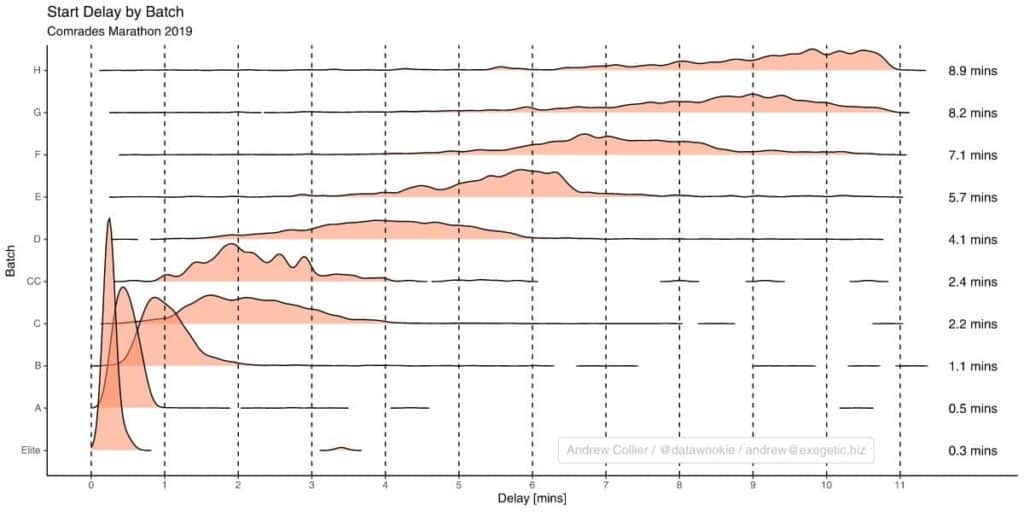
Like most major marathons around the world, the Comrades Marathon uses a seeding system to stagger the start. In basic terms, faster runners start in the front and slower runners at the back.
As a runner, where you get to start in these Comrades Marathon seeding batches (or start corrals as they are sometimes called) is linked to your Comrades qualifying time.
In this article, we are going to look at EVERYTHING related to Comrades Marathon seeding, including (You can click on any of the links to go directly to that section)
- The 9 Comrades Marathon Seeding Batches
- Qualifying Times per Comrades Seeding Batch
- The Comrades Marathon Charity Seeding Batch
- How long does it take to cross the start line per Comrades Seeding Batch
We’re also going to share a legal way for you to ‘Cheat’ your Comrades seeding that will allow you to start closer to the front…
The 9 Comrades Marathon Seeding Batches
There are 9 Comrades Marathon seeding batches at the start of the Comrades Marathon. They are labelled alphabetically and start with A and progress through to H as your qualifying time gets slower.
Below is the Comrades Marathon seeding table that includes all the qualifying standards for each Comrades seeding batch:
Comrades seeding table according to your qualifying time
| Batch | 42.2 km | 48 – 50 km | 52 – 54 km | 56 km | 60 km | 64 km | 68 km | 80 km | 90km | 100 km |
| A | 02:59:59 | 03:39:59 | 03:59:59 | 04:04:59 | 04:34:59 | 04:54:59 | 05:19:59 | 06:29:59 | 07:29:59 | 08:14:59 |
| B | 03:19:59 | 03:59:59 | 04:19:59 | 04:34:59 | 04:59:59 | 05:24:59 | 05:49:59 | 07:09:59 | 08:14:59 | 09:14:59 |
| C | 03:39:59 | 04:24:59 | 04:49:59 | 04:59:59 | 05:24:59 | 05:49:59 | 06:19:59 | 07:44:59 | 08:59:59 | 10:14:59 |
| CC | AmaBeadiBeadi Charity Batch | |||||||||
| D | 03:59:59 | 04:49:59 | 05:14:59 | 05:29:59 | 05:59:59 | 06:29:59 | 06:59:59 | 08:29:59 | 09:44:59 | 10:59:59 |
| E | Green Number Club | |||||||||
| F | 04:19:59 | 05:14:59 | 05:44:59 | 05:59:59 | 06:29:59 | 06:59:59 | 07:29:59 | 09:09:59 | 10:29:59 | 11:44:59 |
| G | 04:34:59 | 05:34:59 | 06:04:59 | 06:24:59 | 06:59:59 | 07:34:59 | 08:09:59 | 09:59:59 | 11:29:59 | 12:29:59 |
| H | 04:49:59 | 05:49:59 | 06:24:59 | 06:44:59 | 07:19:59 | 07:54:59 | 08:29:59 | 10:24:59 | 11:59:59 | 13:29:59 |
In order to run the Comrades Marathon, you need to qualify. The Comrades qualification criteria is quite strict and we’ve written an extensive post on everything you need to know about Comrades Marathon qualification. You can read that post by clicking here.
Let’s dig into the data above in a bit more detail…
If you take a look at the table above you’ll notice that in order to start in the A seeding batch you would need to run a marathon in under 3 hours. A sub 3:20 marathon would see you able to start in B, while a marathon under 3:40 allows you to start in C.
The CC batch is for those that qualify because of their charitable efforts (more on that here), while dipping under 4 hours over 42.2km or 26 miles will see you start in D.
For those Comrades runners that have successfully completed 10 or more Comrades Marathons (The Green Number Club), they are able to start in the E batch as long as they meet the qualification criteria for that year.
Running a marathon in under 4:20 will get you an F batch start, under 4:35 an H and a sub 4:50 a G.
Using your Ironman Marathon for your Comrades seeding
Completing a full Ironman also qualifies you to run Comrades, even if you don’t run the marathon leg in under 4:50.
A sub 3:30 Ironman marathon will see you start in A batch. A sub 3:50 in B, a sub 4:15 in C and a sub 4:40 in D. If you dip under 5 hours you can start in F, under 5:20 in G and simply finish the race (regardless of your marathon time) allow you to start in H.
The Comrades Charity Seeding Batch
One way to “leap-frog” seeding batches and start in a better Comrades seeding batch than you qualified for, is to raise some money for one of the official amaBeadiBeadi charities through the Comrades Race4Charity platform.
Fun Fact: The Race4Charity initiative was started by one of our team members here at Coach Parry, Brad Brown. It was first introduced in 2011 and since then has raised tens of millions of Rand for the official Comrades Charities.The process to raise funds for one of the charities is not that clear on the Comrades website but in a nutshell, this is how to do it:
- Create a fundraising profile within your regular profile on the Comrades website
- Select the charity you would like to support & set a fundraising goal (a minimum of R6000 is needed to get you in the CC seeding batch)
- Then tell your friends and family about it and share your unique fundraising page link
If you are a marginal qualifier, the CC Comrades seeding batch is a great place to start to save yourself a little bit of time on race day.
How much time will you save starting in the CC Comrades seeding batch?
You can listen to this short podcast on how much time you can save in the Comrades charity batch:
One thing you do need to be wary of however when you start in the CC seeding batch is to make sure that you don’t start too fast. If you don’t hold back in the early stages of Comrades, you’ll be forced to pay that time back – and then some – later in the race.
Speaking of time-related to the Comrades Marathon seeding batches, a question that we get asked a lot is…
How long does it take to cross the start line at the Comrades Marathon?
This is a great question and one that leads people to race qualifiers in order to get a better seeding when they actually shouldn’t. (We’ve written an extensive post on why you shouldn’t try and improve your Comrades seeding in the 3 months leading up to race day and what to do instead).
So, how much time do you actually lose in the different Comrades Marathon seeding batches?
On average, the amount of time it takes to cross the Comrades start line in seeding batch A is 30 seconds. Batch B clears the start line in 1:07. Those in C batch will get over the line in about 2:15. Seeding batch D takes 4:05 while the green numbers in E take 5:41. For F batch it’s 7:07. G batch takes 8:13. For those runners in the final and largest seeding batch, H batch takes on average 8:52 to cross the start line.
Let’s dig into where these numbers come from and what they mean in more detail…
As anyone who has run the Comrades Marathon will tell you, the Comrades start is very congested. It does tend to get a bit more congested in Pietermaritzburg for the start of the down run, because the roads there are a bit narrower than Durban.
Senior Data Scientist, Andrew Collier did some great analysis of the timing data coming out of the 2019 Comrades Marathon up run. If you’d like to read his analysis you can by clicking here.
As you will see from the table below, the last athlete in the final seeding batch crossed the start line in 11 minutes and 8 seconds. Column 2 (Time of last athletes across line) is a representation of how long it took the last athlete in each seeding batch to cross the start line.
You might be wondering how on earth can it take someone in A batch, for example, 10’25” to cross the line. What has happened in that case is they have not started in A batch. They may well have started in G or H.
| Batch | Time of last athlete across line | Average time to cross line | Median time to cross line |
| A | 10’25” | 00’30” | 00’28” |
| B | 11’10” | 01’07” | 00’59” |
| C | 10’50” | 02’15” | 02’09” |
| CC | 10’34” | 02’24” | 02’11” |
| D | 10’33” | 04’05” | 04’03” |
| E | 10’49” | 05’41” | 05’44” |
| F | 10’52” | 07’07” | 07’05” |
| G | 10’53” | 08’13” | 08’36” |
| H | 11’08” | 08’52” | 09’23” |
The image below is a graphic representation of all the runners that started Comrades in 2019 and how long it took them to cross the start line.
You’ll notice that as the seeding batches get larger (F, G & H), the time it takes for the first runners in the batch to cross the line to the last, gets longer. That is one of the reasons you want to get to the start and into your seeding batch as early as possible

As a parting shot, it’s important to realise you are going to lose some time when crossing the start line. Due to the sheer number of runners, that is to be expected but how you manage that is what matters.
Starting Comrades conservatively is crucial if you are to have a successful run. It’s vital that you don’t try and make the time up that you feel you have lost at the start, and due to the congestion, over the first few kilometres.
This short podcast will talk you through how to run your own race, regardless of what seeding batch you start it…
Holding back in the early stages will allow you to make that time up as the day progresses. Comrades pacing however is a long discussion for another day…



Comments are closed.